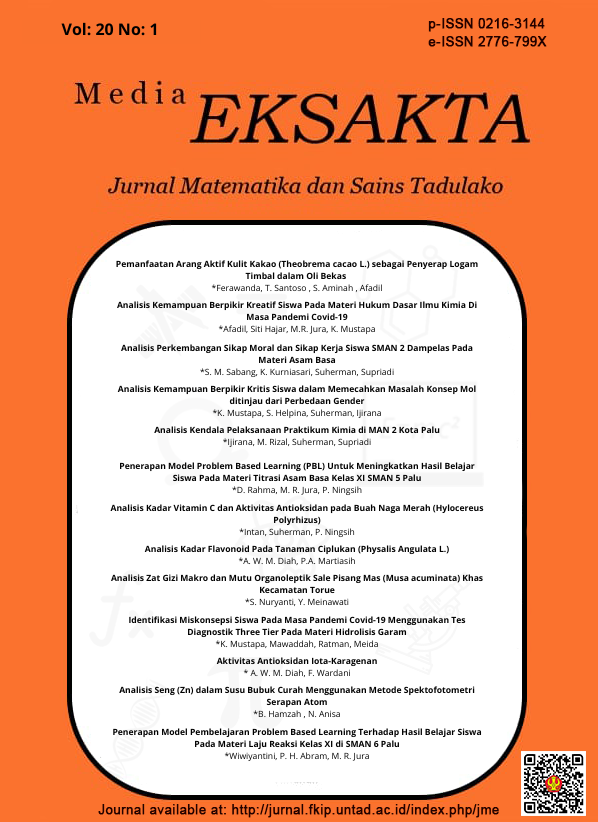Identification of Student Misconceptions During the Covid-19 Pandemic Using Three Tier Diagnostic Tests on Salt Hydrolysis Material
DOI:
https://doi.org/10.22487/me.v19i2.1439Keywords:
Misconception, Three tier Diagnostic Test, Salt Hydrolysis, Covid-19Abstract
This study aims to determine the level of misconceptions experienced by students in the material of salt hydrolysis in class XI of SMA Negeri 1 Tojo, Tojo Una-una Regency. This study was conducted in April-June 2021. The sample used in this study were students of class XI IPA 1 and XI IPA 2 with a total of 40 students. The research method used is descriptive quantitative. Data analysis uses descriptive statistics with percentages. The sampling technique is random sampling. The research instrument used is a three-tier multiple-choice diagnostic test. The results of the study were that the level of student understanding was 33%. Not Understanding the Concept was 25%. Misconceptions were 42%. The highest category of misconceptions was in the sub-concept of Hydrolysis Reaction 47.5%, Percentage of misconceptions based on question items, the highest level of misconception was in question item number 6 with a percentage of 82.5%. While the lowest percentage of misconceptions was in question items 13 and 5 with a percentage of 15%.
References
Riadi, S., Normelani, E., Efendi, M., Safitri, I., & Tsabita, G. F. I, “Persepsi Mahasiswa Prodi S1 Geografi FISIP ULM Terhadap Kuliah Online Di Masa Pandemi Covid-19”, PADARINGAN, 2(2), 2020, pp 219–227.
Mayasari, F., Dwita, D., Jupendri, J., Jayus, J., Nazhifah, N., Hanafi, K., & Putra, N. M, “Pelatihan Komunikasi Efektif Media Pembelajaran Google Classroom Bagi Guru Man 2 Model Pekanbaru”, Jurnal Pengabdian UntukMu Negeri, 3(1), 2019, pp 18-23.
Auliyani, A., Hanum, L., & Khaldun, I, “Analisis Kesulitan Pemahaman Siswa pada Materi Sifat Koligatif Larutan dengan Menggunakan Three-Tier Multiple Choice Diagnostic test di Kelas XII IPA 2 SMA Negeri 5 Banda Aceh”, Jurnal Ilmiah Mahasiswa Pendidikan Kimia, 2(1), 2018, pp 55–64.
Muhammad Nazar, Sulastri, Sri Winarni, R. F, “Identifikasi Miskonsepsi Siswa Sma Pada Konsep Faktor-Faktor Yang Mempengaruhi Laju Reaksi”, Jurnal Biologi Edukasi, 2(3), 2010, pp 49–53.
Utari, G. P., & Liliawati, W, “Identifikasi miskonsepsi siswa pada materi suhu dan kalormenggunakan four tier diagnostic test di SMA”, Prosiding Seminar Nasional Fisika 5.0, 0, 2019, pp 86–98.
Putranto, Adi, Indah Langitasari, and Euis Nursaâ. "Pengembangan Instrumen Three Tier Test Pada Konsep Atom, Ion, Dan Molekul." Jurnal Zarah 8.1, 2020, pp 1-6.
Rares, H. F., Caroles, J. D. S., & Soru, E. A, “Pemetaan Tingkat Penguasaan Konsep Elektrokimia Mahasiswa Kimia Semester II dengan Three-tier Diagnostic Test. 2(1), 2020, pp 1–9.
Kurniyatul, F, “Miskonsepsi dalam Pembelajaran IPA. Jurnal Pendidikan, Komunikasi dan Pemikiran Hukum Islam. 8 (1), 2016, pp 115-128
Siti, S., Yuliani, Y., & Ahmad, B. “Miskonsepsi siswa pada materi struktur dan fungsi jaringan tumbuhan dengan menggunakan three-tier test.” Journal biologi education 7(2), 2018, pp. 365-370.
Kurniawan, Y., dan A. Suhandi. 2015. The Three Tier-Test for Identification The Quantity of Students’ Misconception on Newton’s First Laws. Global Illuminators. 2: 313-319.
Murni, D, “Identifikasi Miskonsepsi Mahasiswa Pada Konsep Substansi Genetika Menggunakan Certainty of Response Index (CRI)”, Prosiding Semirata FMIPA Universitas Lampung, 2013, pp 205–212.
Prastuti, I,W., Suharti, dan Ibnu, S, “Miskonsepsi Peserta didik pada Materi Larutan Buffer”, Jurnal Penelitian, 1(4), 2016, pp 2307-2313.
Maratusholihah, N. F., Rahayu, S., & Fajaroh, F, “Analisis Miskonsepsi Siswa SMA pada Materi Hidrolisis Garam dan Larutan Penyangga”, Jurnal Pendidikan: Teori, Penelitian, dan Pengembangan, 2(7), 2017, pp 919-926.
Von Aufschnaiter, C., & Rogge, C, “Misconceptions or missing conceptions?”, Eurasia Journal of Mathematics, Science and Technology Education, 6(1), 2010, pp 3-18.
Karakus, O., Howard-Jones, P. A., & Jay, T, “Primary and secondary school teachers’ knowledge and misconceptions about the brain in Turkey”, Procedia-Social and Behavioral Sciences, 174, 2016, pp 1933-1940.
Downloads
Published
How to Cite
License
Copyright (c) 2023 Kasmudin Mustapa, Mawaddah, Ratman, Meida

This work is licensed under a Creative Commons Attribution-ShareAlike 4.0 International License.
Authors who publish with Jurnal Media Eksakta agree to the following terms:
- Authors retain copyright and grant the journal right of first publication with the work simultaneously licensed under a Creative Commons Attribution License (CC BY-SA 4.0) that allows others to share the work with an acknowledgment of the work's authorship and initial publication in this journal.
- Authors are able to enter into separate, additional contractual arrangements for the non-exclusive distribution of the journal's published version of the work (e.g., post it to an institutional repository or publish it in a book), with an acknowledgment of its initial publication in this journal.
- Authors are permitted and encouraged to post their work online (e.g., in institutional repositories or on their website) prior to and during the submission process, as it can lead to productive exchanges, as well as earlier and greater citation of published work.




